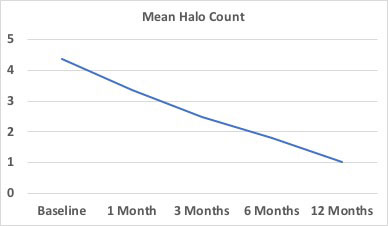Session Information
Date: Saturday, November 12, 2022
Title: Vasculitis – Non-ANCA-Associated and Related Disorders Poster I: Giant Cell Arteritis
Session Type: Poster Session A
Session Time: 1:00PM-3:00PM
Background/Purpose: In recent years, Temporal Artery US (TAUS) has become a reliable alternative to biopsy for diagnosing GCA. However, normalisation of pathologic findings have been described as early as 2 days to as late as 7 months after initiation of treatment. Additionally, use of anti-interleukin-6 therapies makes interpretation of ESR and CRP unreliable. Here, we evaluate to role of US in monitoring GCA disease activity.
Methods: We performed a prospective study of all newly diagnosed GCA patients (clinical diagnosis, verified by 2 rheumatologists after 6 months) who had a positive baseline vascular ultrasound (n= 57) presenting to our Rapid Access GCA clinic over 18 months. US of all 6 branches of the TAs and both axillary arteries was performed on all patients using a GE P9 device. Sonographic abnormalities considered indicative of vasculitis in the temporal arteries included the halo sign and non-compressible arteries with a thickened intima-media complex. In the axillary arteries, a halo sign and an intima-media thickness of >1.0mm was considered positive. To quantify the degree of vasculitis, we calculated a Halo Count (HC, number of branches with halo present) and Halo Score (HS, table 1) at each follow-up visit (1, 3, 6 ,12 months). We performed Independent and Paired Samples T-tests assess the utility of HC and HS in diagnosing and monitoring GCA.
Results: Our cohort consisted of 61% males (n=35) with a mean age of 74.4 years. Baseline HC, HS, CRP and interleukin-6 (but not ESR) correlated with physician-verified diagnosis at 6 months (p< 0.05 for all). Mean HC (Fig. 1) and HS (Fig. 2) for our cohort decreased at each study time-point (p< 0.005 for reductions between each time-point). Baseline HC and HS, but not ESR or CRP, correlated with future biologic requirement (n=19) (p< 0.05 for HC and HS).
Conclusion: Halo quantification using HC and HS can aid in diagnosing GCA with higher scores correlating with physician-verified diagnosis at 6 months. Additionally, our study shows that US may be useful in monitoring GCA disease activity and may replace conventional biomarkers for this purpose. Higher baseline HC and HS also identify which patients require future biologic therapy.
To cite this abstract in AMA style:
Kirby C, Flood R, Mullan R, Murphy G, Kane D. A Prospective Study Evaluating the Utility of Ultrasound in Monitoring Newly-Diagnosed GCA [abstract]. Arthritis Rheumatol. 2022; 74 (suppl 9). https://acrabstracts.org/abstract/a-prospective-study-evaluating-the-utility-of-ultrasound-in-monitoring-newly-diagnosed-gca/. Accessed .« Back to ACR Convergence 2022
ACR Meeting Abstracts - https://acrabstracts.org/abstract/a-prospective-study-evaluating-the-utility-of-ultrasound-in-monitoring-newly-diagnosed-gca/



